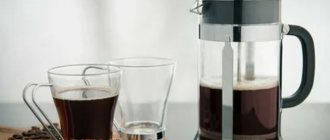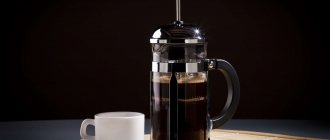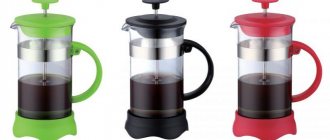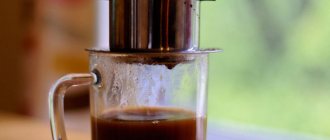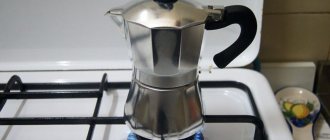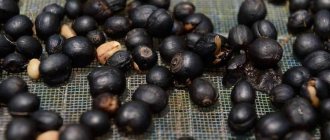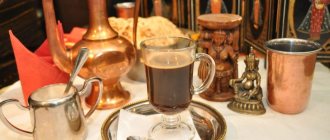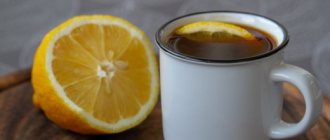A French press is a special compact device that can be used both for brewing coffee at home and tea. We advise you to purchase different devices for their preparation in order to avoid the appearance of a specific taste. The design is simple, it consists of a flask, a filter, a piston, a lid, a body, and a handle. Thanks to the presence of a French press, either a budget or an expensive model, coffee is brewed much easier than in a Turk.
Let's consider in detail: how to properly prepare classic black coffee and aperitifs with milk, what advantages and disadvantages a French press has for coffee and loose-leaf tea. At the end there are useful tips that will be of interest to real gourmets.
The history of the coffee and tea brewer
The first presses appeared in France in the 19th century. Their design did not contain a filter - the finished liquid was combined with the coffee mass. Years later, the Italians added a filtration system to the vessel.
Later, the French gave the teapot a modern look, which earned them the right to call the design a “French press.”
Kitchen devices arrived in Russia in the 2000s. The press was bought for brewing tea, and over the last 5 years they began to use it for preparing coffee variations.
French press: general concept
The French press has remained virtually unchanged since its inception. It has become lighter, the material is more environmentally friendly, and the brewing process is simpler.
Manufacturers offer plastic coffee pots, although coffee lovers condemn this option. Experts believe that drinks prepared in an infuser teach people to distinguish between different flavors.
Design features
The design of the press includes the following elements:
- Container in which coffee drinks are brewed. The material used is glass that is resistant to high temperatures. The structure is breakable. Falling the vessel will cause cracks to appear on the walls of the device, and the seal of the teapot will be broken.
- Three-layer filter. The base is a fine mesh. The material prevents the grain from mixing with the finished drink.
- Plunger. Connects the flask lid to the filter.
- Lid. Made of plastic, steel, ceramics.
- Legs to protect the surface on which the French teapot is installed from water.
- Teapot handle. It can be plastic, sometimes steel, covered with thermal insulation. Metal is more reliable than plastic.
Operating principle and scope
In a French press, it is better to use coarsely ground grains. It is recommended to grind the beans immediately before brewing, preserving their aroma. Before use, wash the French teapot, rinse with hot water, and wipe the walls of the press with a hot towel.
Next, perform the following steps:
- fill the flask with grain - 1.5-2 liters per glass of drink;
- Fill the French teapot halfway with water heated to 95°C;
- after 30 seconds, fill the flask with hot water, leaving 2 cm to the edge of the coffee pot;
- let the water with the grain sit in the press for 3-4 minutes;
- lower the plunger with the filter so that it touches the drink particles that have settled on the bottom of the press;
- leave the French press for 2 minutes, finishing brewing the liquid;
- pour the liquid into cups.
Varieties
The market offers a wide variety of French presses.
Models are classified according to parameters:
- material for making the container, coffee pot body;
- water volume;
- number of flask walls (1 or 2);
- teapot manufacturer, design;
- material of the flask body, piston;
- press design and filter material.
Advantages
The French press has many more advantages than the inconveniences associated with its use.
Among the advantages of French coffee pots:
- Low price of coffee pots.
- The teapot is easy to care for. The device is quickly disassembled, the press body is washed with a sponge.
- There is no regular purchase of a filter or other elements. The press is beneficial to use.
- The French press is compact. The teapot is easy to place in the office or kitchen.
- By adjusting the amount of mixture, water, and infusion time, it is easy to control the strength of the drink.
- Coffee prepared in a French press is free of foreign odors and impurities, and the drink reveals its taste to the maximum.
- Thanks to the filter and plunger, solid particles occupy the bottom of the flask and do not enter the liquid and stomach.
- The brewing process using a press only requires hot water.
Foaming cold milk/espresso cream
Cooling Milk
Cool about 1/2 cup of milk in a small stainless steel glass or bowl.
Place the bowl in the freezer for 15 to 30 minutes or until the temperature reaches just above freezing.
The thicker the milk or cream you use, the thicker your foam will be. However, using milk with a low fat content of 2% or lower may be easier if you froth by hand. Low-fat milk usually includes whey proteins, which are milk foam stabilizers.
Check the bowl to make sure the milk is not frozen. There shouldn't be any ice crystals there.
making coffee with milk in a French press
While the milk is cooling, prepare the espresso. You can then make the foam while the coffee brews.
Remove the bowl from the freezer and place it on a towel on the countertop.
Now you can start frothing milk in several ways.
The first method is to heat the milk on the stove. Mix the milk, then shake and microwave.
The second method is mixing and shaking, but without microwave.
frothing milk
Open the flask and insert the immersion blender. You can also froth the milk in a smaller container for easier frothing. Stir until you get a nice, stiff foam.
milk in a can
Pour the frothy milk into a jar with a lid. Don't fill the jar more than halfway. Leave enough space for the milk to foam. After you have poured the milk, close the lid and shake the jar well.
You can leave the cold foam as is or microwave it if you need extra foam. You should immediately pour it over your drink before it settles.
coffee with milk foam
To do this, take a spoon and place a dollop of foam on top of the drink. Sprinkle with cinnamon to add flavor. You can also pour the milk mixture into your drink.
Selection criteria: what to look for when purchasing
When choosing a device, you are guided by personal preferences, as well as the advice of coffee lovers who have tested models from different manufacturers.
Material of manufacture
Traditionally, the teapot is made of glass. There are metal and plastic models on the market. It is believed that the metal material and plastic add an unpleasant aftertaste. The disadvantage of metal is the opacity of the walls.
The plunger is made of metal or plastic. The first material is easier to maintain and will last longer. The plastic element is lighter and cheaper.
It is better to give preference to models with a filter made of synthetic material, without a silicone ring around the perimeter. This will help avoid mixing solid particles into the liquid and frequently replacing the filter mesh.
When purchasing, evaluate the condition of the coffee pot: there should be no cracks or dents on the walls of the press.
Volume
Since the finished product cannot be stored, choose a teapot with a volume equal to one tea party. For a family of 2 people, a volume of 350 ml is enough. A large vessel of 2-3 liters is suitable for 6-10 guests. When calculating, the proportion is observed: 200 ml of water for each person.
Teapots for different sizes.
Base design
The main requirement for the design of a brewing press is stability. The base of the body should not “walk” while filling the flask or lag behind it.
Steel is more reliable than plastic. Pay attention to the material of the teapot handle. Does the element's coating reliably protect your hands from contact with the hot surface of the coffee pot? The base of the teapot body, as well as the flask, are checked for cracks and chips.
Plunger operation
When buying a French press, check how smoothly the plunger moves along the flask. When moving along the plunger of the kettle walls there should be no jerking, only slight resistance may be present.
If the plunger moves easily, this may mean that the gap between the filter and the housing is larger than expected, which means that the filtration system will allow small particles to pass through.
A metal filter is suitable for retaining large fractions. The synthetic filtration mesh of the plunger will prevent small particles from entering the liquid.
What kind of device is this?
This is a device for brewing coffee, coffee compounds, medicinal herbs, and tea. It is made from various materials, but a convenient, common option is glass. There are additional inserts that help secure the model and make it easier to use. For example, a French press made of bronze has a lightweight design, colorful design, and a price affordable for the average buyer. Such copies can be found in many stores and on online platforms.
In general, the use of metal French presses is widespread. This is due to the affordable cost, ease of use, and structural strength. In this case, different materials are possible; the use of simple metals and alloys is popular. A French press made of stainless steel will last longer than a similar model made of iron or aluminum.
There are expensive models on sale that differ in material and external description. Such examples include French presses made of brass. The average price for one product is 7-8 thousand rubles.
In the listed varieties, the brewing container is mainly made of heat-resistant borosilicate glass. But there are other options, for example, ceramic French presses. They go well with a tea or coffee set, so they are found in gift sets. The inside of the ceramics is coated with a special substance that protects the surface from stains and the absorption of odors. Most models are dishwasher safe.
French press device diagram:
- cylindrical vessel;
- piston (plunger);
- filter;
- lid.
The structure of the road French press is similar to the classic version. The main difference in most cases is the material from which the kitchen mechanism is made. Even heat-resistant and impact-resistant glass can be damaged on the road. For this reason, these options are made of plastic to avoid accidents. There are also varieties with the properties of a thermos.
The disadvantage of plastic flasks can be an unpleasant odor. The problem is common to most cheap models.
When choosing an option, you need to focus on the structure of the filter mesh. It is this detail that will allow you to get a high-quality drink without suspension and sediment from solid particles. The design must fit tightly to the glass, which is often achieved by the presence of a spring. Some examples have up to 4 stainless steel meshes, although cheaper models have only 2.
Popular models for brewing coffee (according to customers)
It’s not easy to navigate the range of teapots. The following are the models that are the most popular according to experts and buyers.
Walmer bamboo
Press for adherents of an eco-friendly lifestyle. The individual elements of the kettle are made of bamboo. The body material looks stylish, the design fits well into a modern interior. Bamboo is stronger than plastic and many other types of wood. The French press will withstand frequent washing, and the container will not lose its attractiveness.
The vessel of the model is made of heat-resistant borosilicate glass. The French press retains heat for a long time. Cups with a volume of 350, 600 and 800 ml are available to customers.
The teapot is steel, stable. The plunger operates smoothly and the filter element isolates solid particles well. There are legs at the bottom of the body. Replacement of the flask is provided. Among the shortcomings, buyers note the cost and loose fixation of the lid.
Teapot from Walmer bamboo.
Coffee gator
Classic metal teapot with a capacity of 1 liter. A profitable solution for a family of 4 people or a small office. The brewing press features an elegant design with a Parisian feel.
The handle is removed from the body, which prevents hand contact with the hot surface. Available in 5 flask colors. The double walls of the container will not allow the water to cool quickly.
The French press is vacuum insulated. Not suitable for those who want to observe the brewing process taking place inside the teapot: the press, piston and filtration system are hidden behind a steel body.
French press Coffee gator.
Polaris French press bizarre-1000fp
A budget French teapot with a simple but functional design. The volume of the glass is 1 l. The brewing container is made of glass, and the supporting structure is made of steel. The material is heat resistant.
The teapot plunger is also metal, so the design will last a long time. The heat-insulated plastic handle is removed from the container body. The design is stable. There is nothing superfluous in the design of the coffee pot.
Laconic Polaris French press teapot bizarre-1000fp.
Kitchen Supreme
German-made equipment. The glass flask is packaged in a stainless steel shell. The brewing container is durable. The Germans took care of the equipment: the coffee pot comes with a long spoon, a scoop for beans, and a book with drink recipes.
The teapot capacity is designed for 8 cups. The filtration element consists of 4 elements, so solid particles cannot enter the liquid. When brewing, the piston moves gently, tightly adjacent to the walls of the container.
French press from the German company Kitchen Supreme.
Taller benton tr-2322
Another French brewing press made of glass with a steel body. The only plastic handle here is. The teapot can be washed in the dishwasher.
The capacity of the French press bowl is 600 ml. There is a measuring scale on the body of the teapot for easy dosing of ingredients. The filter fits tightly to the container. Buyers note the smooth piston stroke and design of the model.
Teapot Taller benton tr-2322.
Sterlingpro double wall
Liter French press made of stainless steel. The lid and handle are steel. Double walls guarantee heat retention and reliability. The filtration element mesh is also double. Minimalistic, discreet design - such a press will fit into any interior. Easy to assemble and disassemble. Soft piston stroke.
Sterlingpro Double Wall Coffee Maker.
Gipfel 7018
A distinctive feature of the model is its volume of 800 ml. The outer part of the French press is made of steel, and the glass is made of glass. Elegant design. The German manufacturer has provided a spare element.
It can be purchased if the factory one becomes unusable. The piston moves gently, the filtration element fits tightly to the inner surface of the teapot.
French press Gipfel 7018.
Jesper (1l) bodum
The 1 liter teapot is made in Scandinavian design. The base of the French press is made of corrosion-resistant steel. According to the manufacturer, the glass of the container is resistant to cracks and temperature changes.
The handle and lid are plastic, but this does not spoil the look. A spare bowl is available to order. The filter is made using press-up technology, which improves water circulation in the kettle. The teapot piston looks elegant.
Jesper coffee pot (1l) bodum.
Maestro mr1665-800
An inexpensive French teapot that combines glass with a plastic frame. The design of the press includes bright colors. The teapot can be washed either by hand or in the dishwasher. The plunger is smooth. Among the disadvantages of the French press, users note the large filter cells.
Budget option from Maestro mr1665-800.
Rondell vintage rds-364
Experts believe that different teapots should be used for tea and coffee. The manufacturer of the model has solved this problem: the kettle comes with two 600 ml flasks.
The spoon will help you dose the coffee bean mixture, and the scale on the outside of the teapot will help you adjust the volume of water. Heat-resistant glass and stainless steel are used in the manufacture of the device. The brewing container is durable. The French press lid is equipped with thermal insulation. It is recommended to wash the device by hand.
French press Rondell vintage rds-364.
Rondell wonder rds-426
Glass French press with a capacity of 0.6 liters. The brewer is distinguished by its non-standard flask design: the top of the body is made of steel, and the lower part and handle of the French press are made of noble black plastic. The filtration element of the plunger is metal, there are no gaps between the brewing container and the press piston.
Teapot from the French company Rondell wonder rds-426.
Alfi French press steel
The device resembles a steel thermos. The French press is made of stainless steel, which perfectly maintains the water temperature required for brewing.
Buyers note the model’s comfortable handle, design, smooth piston with a high-quality filtration system. The design of the French press will appeal to connoisseurs of the classics. Disadvantages include high cost and opaque walls.
Alfi French press steel teapot.
Bodum eileen
The 500 ml device lives up to its name with an elegant and unusual design. The stainless steel body of the model resembles a Brick Screen - a work of art.
It helps maintain the water temperature and protects the walls of the coffee pot from damage when dropped. Glass container. To keep the French press sealed while brewing, there is a valve in the spout. It opens by pressing a button. The piston moves smoothly. The filtration element is steel.
Bodum eileen coffee pot.
Le creuset
A bright representative of ceramic French French presses. There are many collectors of the brand's tableware in the world.
The enamel of the model is reliable and does not absorb odors. French press is available in 16 colors.
Buyers choose a design to match the interior. The piston is steel, and the filtration system is synthetic. The price of the device is high, but the brewing process will turn into a ceremony.
French French press Le creuset.
Kona stainless steel
The shaped frame of the 1 liter teapot is made of red or black steel. The container material is borosilicate glass. The press and filtration structure are a single steel device. The piston moves smoothly. The filtration element isolates water well from the mixture.
French press Kona stainless steel.
Taller elfi tr-2317
The plastic structure wraps around an 800 ml glass beaker. The handle is made of bakelite - a non-heating material. The steel press mechanism of the French press fits tightly to the walls of the container, providing high-level filtration. The elegant design of the kettle will look good in any interior.
Coffee pot Taller elfi tr-2317.
Augustin welz aw-2000
The appearance of the coffee pot refers to old English films. The model will appeal to aesthetes. Acts as a teapot or thermos. The double-walled steel construction keeps the liquid hot for a long time, allowing the beans to release their flavor.
Filter elements reliably isolate solid substances from water. Among the disadvantages, users highlight the opaque walls of the French press and its high dead weight.
Teapot Augustin welz aw-2000.
Rating of the best models
As you already understand, the model range of French presses differs only in design, manufacturing materials and the integrity of the manufacturer.
To simplify the choice, we have compiled our own small rating of manufacturers whose products we have already evaluated in practice. As always, we warn you about the complete subjectivity of the approach. It is based only on our own impression at the “like-dislike” level.
1 place. Bodum
The Danish brand is represented by a whole constellation of French presses of different sizes and designs. Colored lids, comfortable handles that do not heat up, durable borosilicate glass and metal filters. The dishes last a long time, and cost quite a lot of money - from 2.5 thousand rubles.
2nd place. Bialetti
Coffee lovers know this name very well from geyser coffee makers. Bialetti French presses are distinguished by decent build quality and production. A definite plus is the comfortable and durable handles. Even a liter coffee pot, full to the brim, is not scary to lift with such handles. The price starts from 2.6-2.8 rubles.
3rd place. Hario
The Japanese brand specializes in making tableware, and pour-overs have brought it worldwide fame. French presses made in Japan are durable, stylish in design and reliable in construction. Comfortable handles and stands, strong lids, metal mesh filter. The biggest drawback is the high price. A miniature press of 240 ml will cost from 1.5-2 thousand rubles.
4th place. Tescoma
Chinese cookware brand has a good reputation. French presses cannot boast of a variety of designs, but they are practical. Comfortable handles, good piston stroke. The downside is that they need to be dried after use, otherwise they can quickly rust. Cost – from 1.5 thousand rubles.
5th place. Taller
Chinese products have a traditionally affordable price. Among the minuses, we note that the design of the handle and lid is not always successful. In many models they are metal and heat up quickly. But the price from 600 rubles is very attractive.
Operating instructions: tips and recommendations
For a French press to last long, it must be used correctly.
Coffee grinding degree and dosage
When choosing a grind, pay attention to the structure of the filter. The finer the mesh cells of the press, the less coarse the grains can be ground. For a metal press, a grind the size of grains of sea salt is suitable. It is recommended to take 60 g of grain per 1 liter of water. Use a measuring spoon.
Water temperature
The optimal water temperature is 95°C. To avoid mistakes, use a thermometer. If there is no device for measuring temperature, bring the water to a boil and then cool for 1 minute. Then water is poured into the container.
Extraction
To get a high-quality result, the flask is heated before use, rinsed with hot water. After the grains are poured in and the water is poured in, the mixture is lightly stirred with a wooden spatula.
You cannot immediately lower the piston - first the liquid in the container must sit for the required time.
Once ready, the liquid is immediately poured into cups to prevent the grains from being over-extracted.
Selection of ingredients
How to brew coffee to get the perfect drink? Let's share our tricks.
Coffee should be brewed in pre-purified/bottled water at a temperature of 92-95 degrees. Boil the kettle, wait half a minute - the water is ready to use. What is the optimal grind? Buy ground beans in their original packaging or grind them yourself in a coffee grinder, choosing a coarse (coarse) coffee grind.
How many spoons should you use? Baristas use ratios in a wide range - from 1:10 to 1:18. If you put lightly roasted ground beans into a French press, the quantity increases. During heat treatment, grains lose less moisture and, accordingly, weigh more.
Try starting with the standard recipe: 1.5 heaped tablespoons of coffee per 200 ml. After tasting, you will understand how to prepare coffee according to your personal requirements.
Coffee recipes
Expensive models of coffee pots often come with booklets with drink recipes. Below are the most popular cooking methods.
Classical
To prepare the drink, you only need a press, water and coffee. The grains are ground while simultaneously heating the French press with hot water. After the dry mixture is poured into the container, it is filled with water at the desired temperature and left for 4-5 minutes.
Warsaw style
This recipe requires the following ingredients:
- 50 ml water;
- 50 g coffee;
- brown cane sugar;
- 450 ml milk.
The milk is heated while simultaneously heating the coffee pot. Pour ground coffee and sugar into it. Pour the mixture with water. Leave for 1-2 minutes, after which milk is added to the press. After 3 minutes, the piston is lowered and the finished liquid is poured into cups.
Warsaw style coffee in French press.
Latte
Ground cinnamon will be added to the products from the previous recipe.
The procedure will be as follows:
- Pour coffee into the teapot and fill it halfway with water;
- close for 3 minutes, then pour the water into a container with a spout and rinse the brewing container;
- pour hot milk into the teapot, insert the piston and quickly pull the plunger up to form foam;
- pour the resulting milk mixture into another container, then pour coffee into it in a thin stream;
- sprinkle the drink with cinnamon to taste.
Best Inexpensive French Presses with Plastic Base
If you need a budget model, you should pay attention to a French press with a food-grade plastic body. Such products are light, comfortable, look aesthetically pleasing, although they have a short service life. In order for the teapot to last as long as possible, it must have a fireproof glass flask, a metal piston and a steel filter.
Alpenkok AK-710/80, 800 ml
4.8
★★★★★
editorial assessment
93%
buyers recommend this product
The Alpenkok brand has released a nice 800 ml French press made of bright red plastic. A heat-resistant glass flask is inserted inside the body. The device is covered with a lid with a built-in piston and a fine-mesh stainless steel filter. The cup holder does not heat up and does not slip on a wet surface.
Pros:
- transparent bowl made of heat-resistant glass;
- high quality strainer.
- organic design.
Minuses:
- thin plastic.
Alpenkok does not allow small grains of tea leaves to pass through, is easy to clean and has a beautiful design.
TimA Muffin PM-600
4.8
★★★★★
editorial assessment
88%
buyers recommend this product
The 600 ml Muffin French Press bowl is made of borosilicate glass, which is highly durable. The plastic body is resistant to chips and scratches, and the wide handle does not heat up. The lid has a gasket to ensure maximum seal to the edges of the flask. Transparent walls make it possible to observe how the drink is brewed.
Pros:
- steel filter;
- tight lid;
- stable base;
- relatively light weight (0.5 kg).
Minuses:
- small tea leaves slip through the mesh into the cup.
TimA Muffin looks stylish and looks harmonious at home and in the office.
Dolyana Oliver
4.6
★★★★★
editorial assessment
84%
buyers recommend this product
A light pink French press from the manufacturer Dolyana is designed for 350 ml of water. The 12 cm high cylindrical glass flask is inserted into a plastic base with a convenient stand and handle. The steel filter can be used for making coffee, tea, and herbal infusions. The teapot does not absorb foreign odors and can be easily washed with warm water.
Pros:
- Nice colour;
- tight lid;
- environmentally friendly plastic without any foreign smell;
- ergonomic handle.
Minuses:
- fragile flask.
The glass of the teapot is not durable. The case protects it from damage, but despite this, the service life of the Dolyan French press is less than that of other teapots in this price category.
Apollo genio piston kettle Soho
4.5
★★★★★
editorial assessment
80%
buyers recommend this product
A piston kettle in yellow-lilac tones is intended for tea, herbal drinks, cocoa, coffee. The frame is made of thick plastic, impervious to temperature changes, the 600 ml flask is glass. The handle does not heat up and ensures safety. The lid has an additional filter that traps tea leaves.
Pros:
- tight piston;
- a steel filter and another one in the lid;
- ease of operation;
- high taste qualities of drinks.
Minuses:
- The glass is difficult to wash with a brush - scratches appear on it.
The Apollo kettle allows you to quickly prepare your favorite drink and is dishwasher safe. It filters tea leaves and coffee grounds well.
Vetta Lace
4.4
★★★★★
editorial assessment
80%
buyers recommend this product
A beautiful small French press “Lace” holds 350 ml of water (the manufacturer has a similar model with a capacity of 600 ml). The glass flask is decorated with an original design and is tightly inserted into the plastic base.
The piston is made of plastic, the filter is made of nylon threads. There is also a strainer on the spout. The handle of the teapot does not get hot, and the silicone stand prevents slipping on a flat surface.
Pros:
- Suitable for brewing various drinks;
- comfortable spout shape;
- double filtration;
- elegant design;
- cheap.
Minuses:
- thin glass.
The plastic piston absorbs the aroma of coffee and tea. To prevent this, it is recommended to wash the device thoroughly immediately after use.
Features of device care
Simple rules of care will help keep the device operational and the appearance of the kettle presentable for many years:
- after each use, the brewing press is disassembled and washed with running water, following the attached instructions;
- Do not use detergents when washing the teapot, because their smell will overwhelm the aroma of the drink the next time it is prepared;
- after cleaning, wipe the plunger and structure dry, protecting it from streaks;
- Keep the device away from household chemicals and products with odors.
Mistakes when brewing coffee
If the taste of the prepared drink is disappointing, mistakes may have been made:
- The wrong type of coffee has been selected. For French press, it is better to use high quality grains with berry or fruit notes.
- The filtration system is poorly cleaned. This can cause the coffee to taste musty.
- Grind is not coarse enough. This causes coffee dust to end up in the cup. Bitterness may occur due to rapid extraction.
- The drink was kept in a coffee pot. This makes it bitter, too strong.
Disadvantages of using a French press
It is not easy to find flaws in a simple and ergonomic device.
The disadvantages of using a French press include:
- fragility of the teapot if it is glass;
- the need for manual brewing as opposed to a coffee machine;
- There should be a kettle or other device for heating water on hand.
In all other respects, the French coffee pot raises no complaints. By experimenting with different varieties, adding spices, and controlling the brewing time, it’s easy to surprise your loved ones with new tastes.
Cold coffee
Wondering how to make coffee special in a universal device? We tell you how to do it correctly.
- Add ground grains at the rate of 1 tbsp. spoon for 200 ml.
- Pour in cold water and mix thoroughly.
- Place in the refrigerator for 12 hours.
- Take it out, insert the piston, squeeze out the grounds.
You should understand: the drink is brewed for a long time, therefore it turns out rich and bitter. Add spices, milk, cream, ice cubes.
Is it possible to cook your favorite elite varieties in a French press? Certainly! Having gained experience, you will get the best coffee to enjoy with a unique bouquet of flavor and aromatic properties. Adjust the degree of grinding and the duration of infusion. Our article is a guide to action in order to gain an understanding over time of how to choose the optimal parameters according to your preferences.
